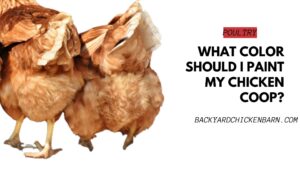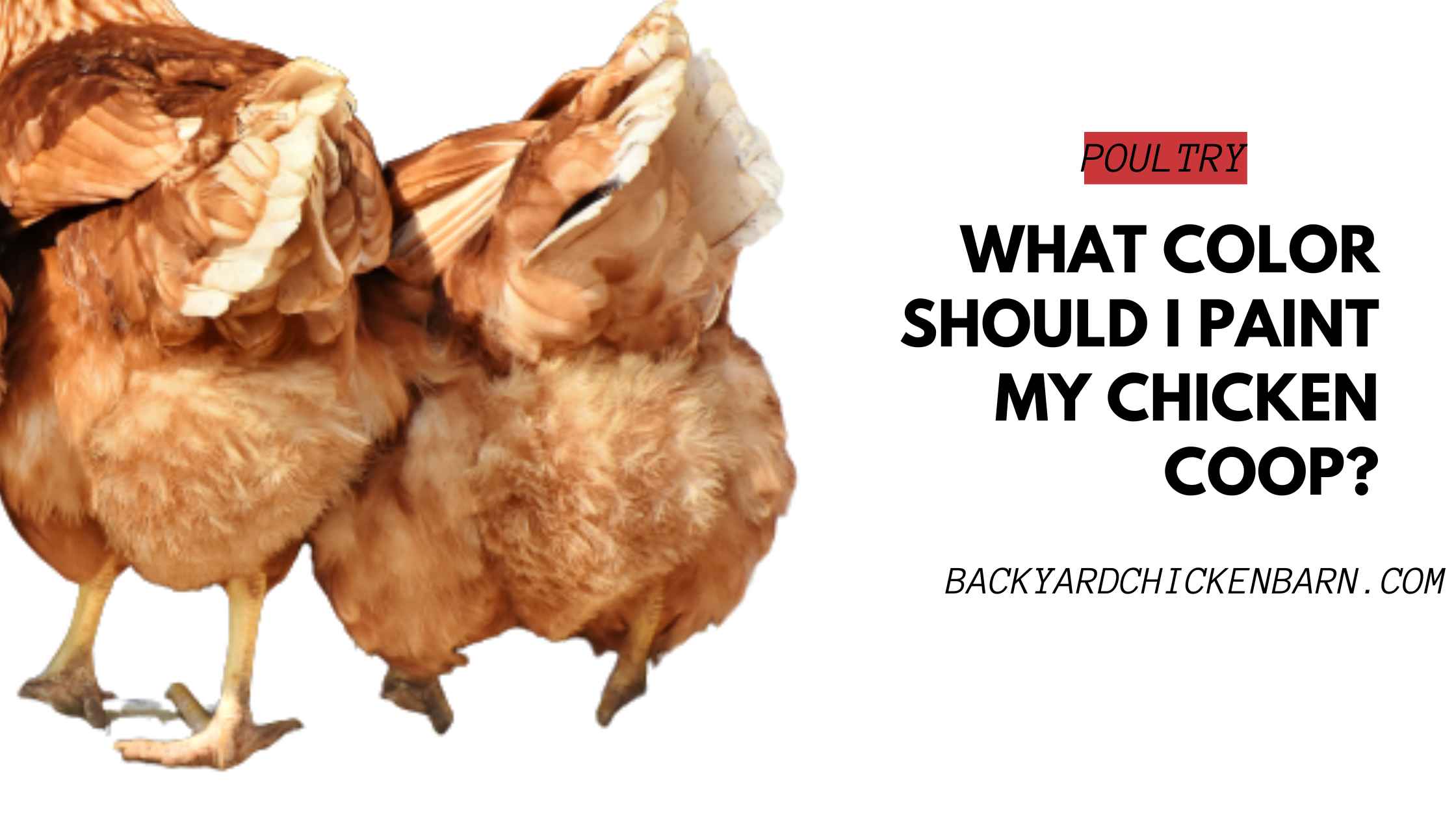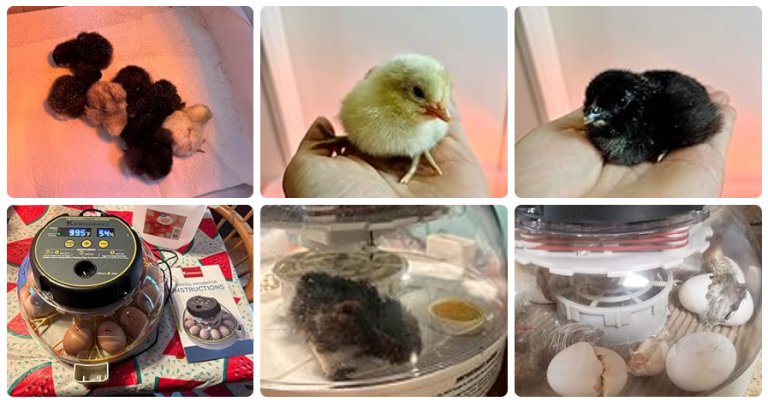What Color Should I Paint My Chicken Coop?
The visual appeal of our gardens, homes, and even chicken coops play a significant role in how we perceive and interact with our environment.
As I embarked on my journey into backyard poultry-keeping, I faced the seemingly small yet surprisingly significant question: “What color should I paint my chicken coop?”
In my experience, and after much research, a light or pastel shade is typically recommended for chicken coops. Such hues not only aesthetically please the eye but also reflect sunlight, keeping the coop cooler during warmer months.
But, as with many things in life, there’s more to color selection than meets the eye. Here’s a deeper dive into the world of coop colors, based on personal experiences and research:
1. Light Colors for Coolness:
Painting your coop in light colors like white, beige, or pastels helps in reflecting sunlight. This can be especially beneficial in areas experiencing hot summers, as it prevents the coop from becoming a heat trap.
2. Bright and Cheery:
If you’re someone (like me) who enjoys a splash of vibrancy in the garden, consider cheerful colors like turquoise, light blue, or sunny yellow.
Not only will these shades lift your spirits, but they also make spotting dirt or pests easier.
3. Natural and Earthy:
For those aiming for a rustic or natural aesthetic, browns, greens, or taupe can seamlessly blend your coop with the surrounding environment.
4. Darker Hues for Cold Climates:
If you’re in an area with cooler climates, darker shades can be considered. These colors absorb heat, helping to keep the interiors warm during colder months.
5. Personal Touch:
Your chicken coop can be an extension of your personality. Painting it in your favorite shade, or matching it with the color scheme of your house or garden, adds a personal touch and makes it truly yours.
6. Practical Considerations:
Remember, while aesthetics matter, practicality does too. Lighter colors might require more frequent cleaning, while darker colors can show scratches or peeling more distinctly.
7. The Interior Matters Too:
While much focus is on the exterior, the interior color matters as well. A light-colored interior can assist in better visibility, especially during egg collection or cleaning.
8. The Power of Patterns:
Who says it has to be a single color? Introducing patterns, murals, or multicolored palettes can make your coop a standout piece in the garden.
In conclusion, while there’s a practical advantage to selecting light or pastel shades for heat reflection, the color of your chicken coop should resonate with your aesthetic preferences and the needs of your environment.
Over the years, every time I glance over at my pastel blue coop, it brings a smile to my face, knowing I made a choice that’s both functional and close to my heart.
ALSO SEE: How to Bury Hardware Cloth for Chicken Coop

FAQs on Choosing a Color for Your Chicken Coop
1. Why are light colors recommended for chicken coops? Light colors like white, beige, or pastels reflect sunlight, helping to keep the coop cooler during warm months.
2. Can I choose a vibrant color for my coop? Absolutely! Vibrant colors like turquoise, light blue, or sunny yellow can add cheeriness to your garden and make spotting dirt or pests easier.
3. Are natural colors a good choice for coops? Yes, browns, greens, and taupe can offer a rustic look and help the coop blend with its surroundings.
4. Should I consider darker colors if I live in a cold area? Darker colors can absorb heat, making them a viable choice for coops in cooler climates.
5. How can I personalize my chicken coop’s color? Choose a color or pattern that resonates with your personal taste or matches your home’s color scheme.
6. Do light-colored coops require frequent cleaning? Lighter colors might show dirt or stains more easily, so they might need more regular cleaning.
7. What should I consider for the interior color? A light-colored interior can improve visibility for tasks like egg collection and cleaning.
8. Can I paint my coop with multiple colors or patterns? Definitely! Patterns, murals, or multicolored palettes can add a unique touch to your coop.
9. Is there a functional advantage to painting the coop a particular color? Yes, light colors reflect heat, while darker ones absorb it, influencing the coop’s internal temperature.
10. How often should I repaint my chicken coop? It depends on the paint quality and weather conditions but checking and possibly refreshing the paint every 2-3 years is a good practice.
11. Does paint color affect the behavior of the chickens? Chickens aren’t particularly sensitive to color variations, but a pleasant environment can indirectly affect their well-being.
12. Can I use leftover paint from my house for the coop? Yes, but ensure it’s non-toxic and safe for animals.
13. Are there specific paint types recommended for coops? Opt for outdoor, weather-resistant, and non-toxic paints.
14. Can a coop’s color deter predators? While color might not be a primary deterrent, a well-maintained coop can reduce hiding spots for predators.
15. Does paint color affect the coop’s durability? While color itself might not, the quality and type of paint used can impact durability.
16. How can I decide on a color that matches my garden’s aesthetics? Consider the dominant colors in your garden and choose complementary or matching shades.
17. Are there any colors I should avoid? Avoid very dark colors in hot climates as they can excessively heat up the coop.
18. Does paint color influence egg production? Directly, no. But a well-maintained, pleasant environment can support overall chicken health, indirectly affecting egg production.
19. Can I paint the inside and outside of the coop differently? Yes, you can choose different colors or shades for the interior and exterior.
20. How can I test if a color is right for my coop? Paint a small patch and observe it in different lights and times of the day before finalizing.
21. How does paint color affect coop maintenance? Lighter colors might show dirt more, while darker shades can reveal scratches or peeling.
22. Can paint help in pest control? While color might not deter pests, certain paints can be treated or mixed with pest deterrents.
23. Is it expensive to paint a chicken coop? Cost varies based on paint quality and coop size, but it’s generally an affordable enhancement.
24. Can I use patterned stencils for my coop’s design? Certainly! Stencils can add unique designs to your coop.
25. How does a pastel-colored coop look over time? Pastels can fade with prolonged sun exposure, so periodic touch-ups might be needed.
26. Are there benefits to matching the coop color with my house? It can offer a cohesive aesthetic appeal to your property.
27. How can I highlight features of my coop with paint? Using contrasting colors or shades can help in highlighting specific features.
28. What’s the trend in coop colors these days? Trends change, but natural, pastel, and vibrant shades remain perennial favorites.
29. Can paint protect my coop from the elements? Yes, weather-resistant paint can offer protection against moisture and UV rays.
30. Can I seek professional help for painting? Certainly, especially if you desire intricate designs or a flawless finish.
31. How do I prep my coop for painting? Clean the surface, remove old peeling paint, and ensure it’s dry before painting.
32. How long does coop paint typically last? High-quality outdoor paint can last 2-3 years or longer before needing a touch-up.
33. Do chickens have a color preference? Chickens don’t show strong preferences, but a calming environment is always beneficial.
34. Can I use eco-friendly paint for my coop? Absolutely, and it’s a great choice for both the environment and your chickens.
35. What considerations are vital for coop paint apart from color? Non-toxicity, durability, and weather-resistance are crucial.
36. How can I make my coop a garden centerpiece through paint? Opt for vibrant colors or unique designs that stand out and complement your garden.
37. Can I use the same paint for the coop and chicken run? Yes, if it’s durable and non-toxic.
38. Does coop color affect resale value if I decide to sell? While functionality is primary, a well-maintained and aesthetically pleasing coop can have better resale value.
39. Is it essential to paint the coop? While not mandatory, paint offers protection and aesthetic appeal.
40. Can I change my coop’s color frequently? Yes, but ensure you’re using high-quality paint to prevent excessive layering or peeling.



